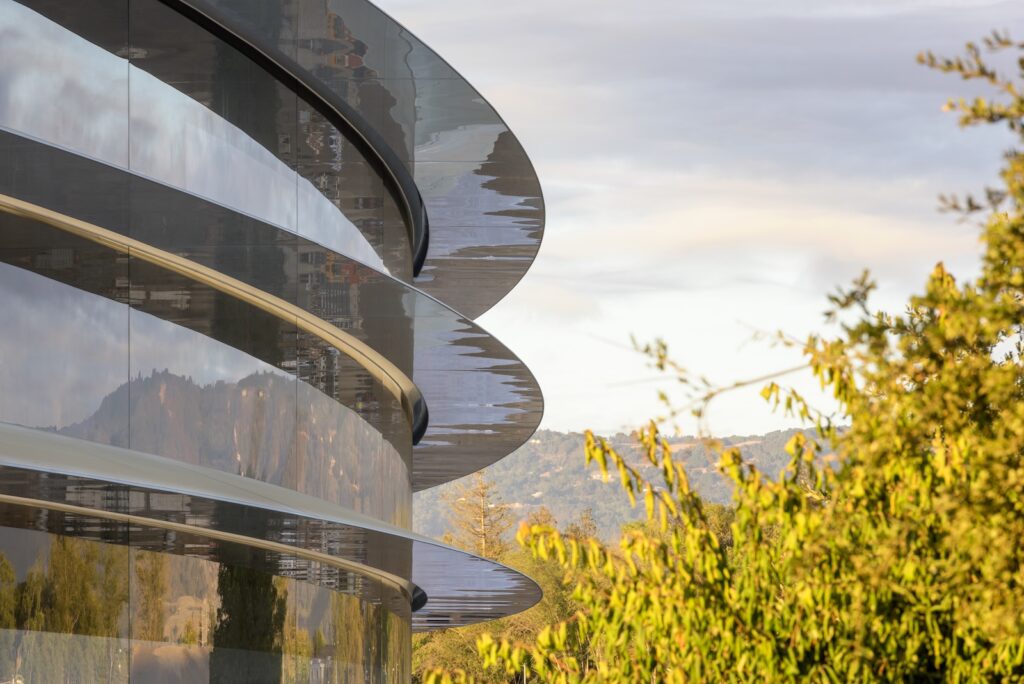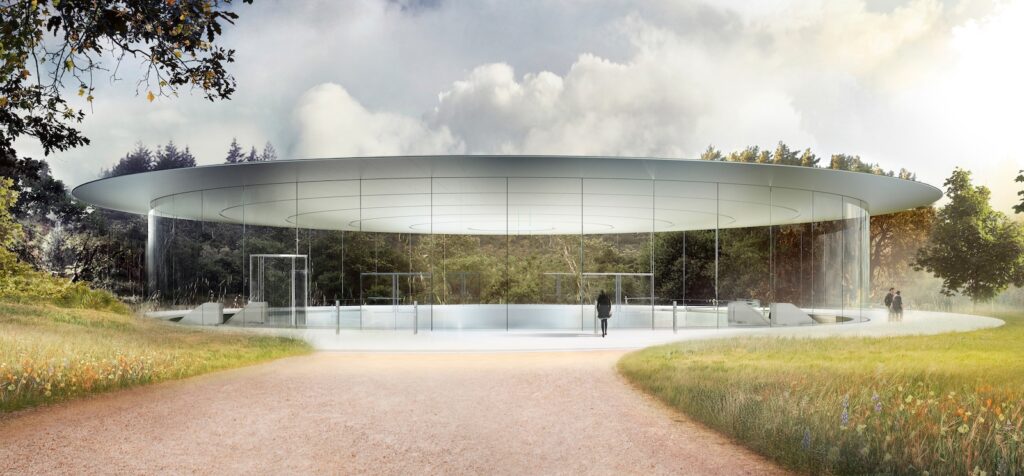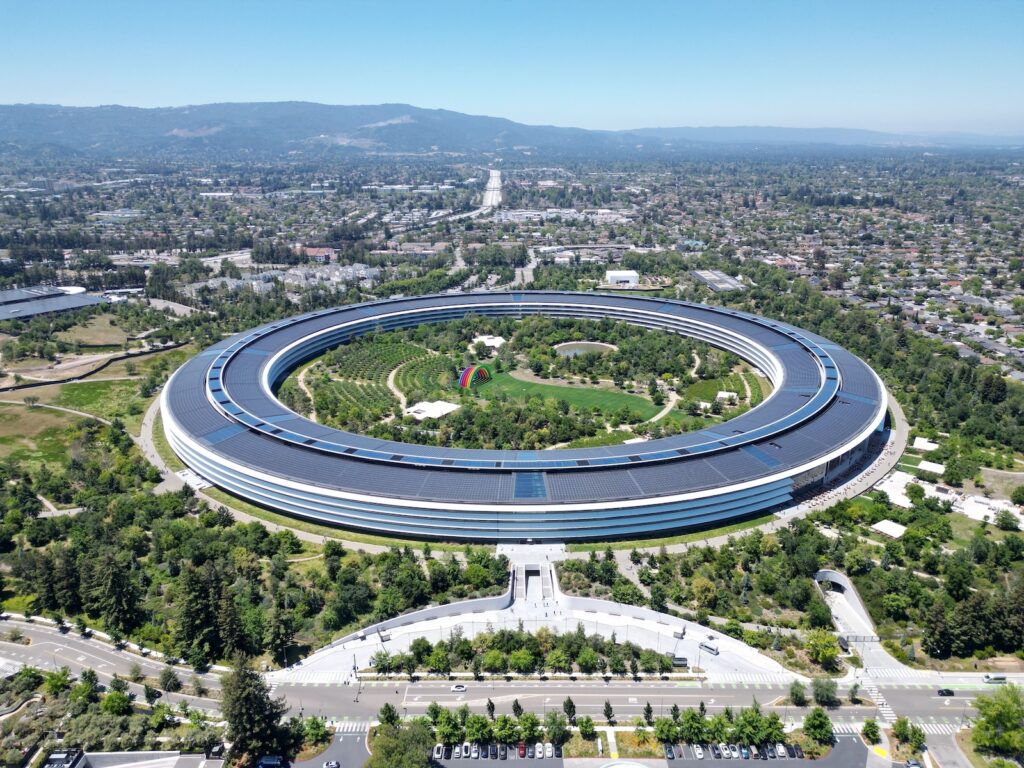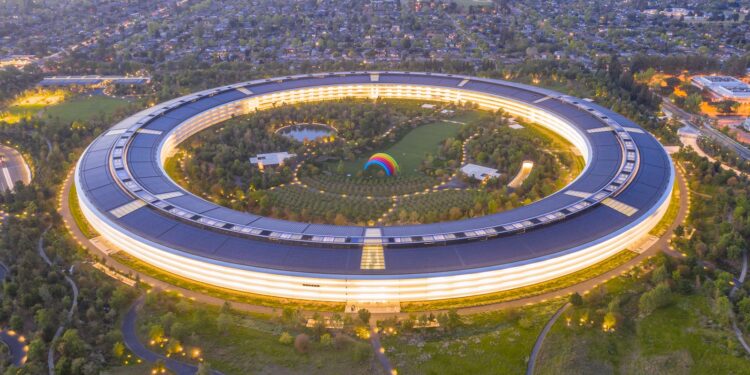Apple Park is more than a building – it's a manifesto. A place that shows how a company can translate its values into architecture. This article tells the story of one of the most ambitious construction projects of the 21st century – from the initial idea to its realization. It sheds light on how technology, nature, and human interaction merge in Apple's headquarters. And it pays tribute to the vision of Steve Jobs, whose last great idea was Apple Park. At the same time, Jobs places Apple Park in architectural history and questions how such a building affects urban development, work culture, and Apple's image. This isn't just about numbers and design, but about the question of what happens when a global technology company builds its own world – with almost unlimited resources.
Apple Park in Cupertino, California, is not just the headquarters of one of the world's largest technology companies. It exemplifies Apple's identity – clear, reduced, elegant, and thought through down to the smallest detail. With a cost of around five billion US dollars, a futuristic ring building for over 12,000 employees, and one of the world's most advanced energy concepts, the campus is considered one of the most ambitious buildings of its time. Born out of Steve Jobs's last great vision, Apple Park also became a place of remembrance. The presentation of the plans in 2011 was one of his last public appearances. He passed away a few months later. Since then, Apple Park has symbolized not only technological and architectural excellence, but also the continuation of his aspiration to harmonize design, function, and humanity – in a space that consciously aims to be more than just a workplace.
The origin of the idea
As early as 2006, Apple began acquiring land in Cupertino, California – discreetly and strategically through subsidiaries to avoid price increases. The goal was to create a closed area for a new campus that would be not only functional but also inspiring. The vision came directly from Steve Jobs: He didn't want to build an ordinary office complex, but a place where people feel equally connected to technology and nature. On June 7, 2011, he presented the plans to the Cupertino City Council. His idea: a campus that would act like a public park while also being at the highest architectural and technical standards. Jobs passed away shortly thereafter – Apple Park remained his last major project. The emotional connection to this building is still felt within the company today. Many employees consider it the founder's material legacy.
Planning and design
Apple enlisted the help of the renowned British architectural firm Foster + Partners, led by Sir Norman Foster, to implement the project. Together with Jony Ive, Apple's legendary Chief Design Officer, they developed a completely new campus model: a giant glass ring embodying elegance, efficiency, and openness. The team was complemented by landscape architects from OLIN and engineers from Arup, who played a key role in the ecological and technical planning. The planning phase spanned several years and was characterized by exceptionally high standards of aesthetics, function, and environmental compatibility. In October 2013, the Cupertino City Council unanimously approved the project – a clear sign of local support for this extraordinary construction project. From the outset, it was clear that Apple wanted to build more than just a building, but a symbol of its brand identity.
The construction process
The official groundbreaking ceremony took place in 2013. Apple originally planned to complete the new campus by the end of 2015. However, the construction of Apple Park proved to be technically and logistically challenging. Design changes, quality requirements, and technical innovations caused delays. The first employees finally moved in in April 2017. Full completion took until the summer of that year. Construction costs were estimated at five billion US dollars. Specialist German companies, including Sedak and Josef Gartner, were commissioned to create the striking glass facade. Hundreds of workers were on site, often under strict conditions – for example, sensitive surfaces could only be touched with gloves to maintain the highest quality standards. The project was also a logistical undertaking: The coordination of the international suppliers alone required detailed time and transport management.

Architecture and Innovation
Apple Park's central ring building has a diameter of 461 meters and houses around 12,000 employees on over 260,000 square meters. The four above-ground floors consist of 800 curved glass panels, each approximately 13.7 meters high – a record in commercial architecture. Beneath the visible part of the building are three underground levels, which include technical rooms, utility infrastructure, storage areas, and parking areas. The access to the Steve Jobs Theater is also underground. The inner courtyard extends over 12 hectares and offers a natural environment with over 9,000 trees, meadows, paths, and an artificial lake. Only high-quality materials such as maple wood were used for the interior design. The ring-shaped structure facilitates internal routes and promotes communication. It also embodies Apple's commitment to functional clarity and aesthetic coherence – visible in every structural decision. The shape of the ring was not just an aesthetic decision, but was also intended to promote communication: no one is more than a few minutes' walk away from each other.
The Steve Jobs Theater
A special architectural highlight on the site is the Steve Jobs Theater – named after the company founder who laid the foundation stone for Apple Park. It is largely underground and has seating for around 1,000 people. The foyer above consists of a fully glazed, circular pavilion supported by an 80-ton carbon fiber roof. The roof is composed of 44 identical panels – a technical masterpiece. The foyer and auditorium are connected by a 13-meter-high, rotating glass elevator – the tallest of its kind in the world. The theater was officially inaugurated on September 12, 2017, with the presentation of the iPhone X. Since then, Apple keynotes have been held here regularly. The combination of transparency and understatement makes the theater an architectural reflection of the Apple philosophy.

Sustainability as a principle
Apple Park is considered one of the most environmentally friendly corporate buildings in the world. It is powered entirely by renewable energy – largely by a 17-megawatt solar array installed on the roof. An additional four megawatts come from biogas fuel cells. An intelligent, natural ventilation system eliminates the need for conventional air conditioning in around 70% of the year. This makes the main building the largest naturally ventilated office in the world. Apple Park is also LEED Platinum certified – the highest award for sustainable construction in the USA. Environmental criteria were also taken into account in the landscaping: Many plants are native to the region and require little water. The construction of Apple Park set new standards for sustainability – not as an add-on, but as an integral part of the overall concept.
Working at Apple Park
Working at Apple Park means much more than just using a workstation. The architecture encourages encounters, exchange, and movement. Wide corridors, open office spaces, and spacious common areas are designed to stimulate creativity and communication. The campus is home to seven cafés, the largest of which seats 3,000 people and serves up to 15,000 meals a day. Employees also have access to a 9,300-square-meter wellness and fitness center, complemented by medical care facilities. Walking paths, bike lanes, and green spaces invite outdoor exercise. A visitor center with an Apple Store, café, AR model of the campus, and observation deck is open to the public—the rest of the campus remains Apple's own. The interplay of design and function makes Apple Park one of the most modern working environments in the world.
Impact on the city and the world of architecture
The impact of Apple Park is felt far beyond Cupertino. Local real estate prices rose, new transportation infrastructure became necessary, and other tech companies also began to rethink their work environments. Architecturally, Apple Park is internationally regarded as a milestone. The radical clarity of its design, the consistent implementation of sustainable principles, and its technical precision are considered benchmarks. However, the lack of urban integration has been criticized: the campus is deliberately isolated, which is controversial in terms of urban planning. Even though Apple Park is a green showcase project, its resource consumption remains remarkably high – due to its size and materials alone. For many architects, it nevertheless represents a lesson in what modern office architecture could look like in the future: not as purely functional space, but as organically planned living space.
Apple Park: A Monument to Apple
Apple Park is far more than a corporate headquarters. It is a physical expression of Apple's brand identity. It stands for perfection, for control, for the spirit of innovation—and for the pursuit of a world of its own, where technology and humanity are conceived together. For many employees, it is an inspiring workplace, for architects, a lesson in integrated planning, and for fans, a symbol of the ideals Apple pursues. What began as the idea of a single man has become one of the most significant buildings in the modern corporate world.

Apple Park is not just the center of a technology company—it's also a place that demonstrates what happens when vision, capital, and consistency converge. Combining architecture, nature, and technology, a space has been created here that represents not only Apple, but an entire era. The best products for you: Our Amazon Storefront offers a wide selection of accessories, including HomeKit. (Image: Shutterstock / SnapASkyline)
- Secure your iPhone properly: 5 important functions at a glance
- Apple Intelligence: Smart AI with maximum data protection
- Why an iPhone? These advantages are convincing in the long term





